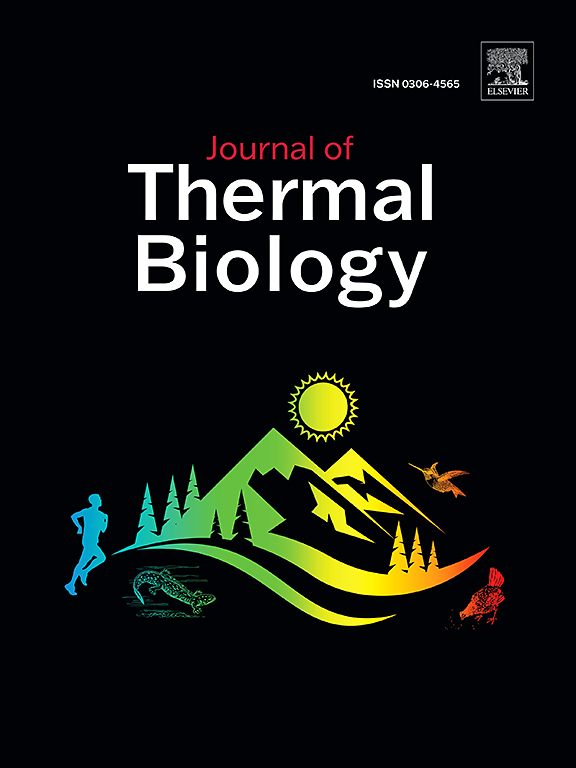手部间歇接触冷热交替刺激五周不会改变手指冷引起的血管扩张反应。
IF 2.9
2区 生物学
Q2 BIOLOGY
引用次数: 0
摘要
我们测试了这样一个假设:手部长时间间歇性暴露于瞬时对比热刺激会增强手指在局部冷却过程中的冷诱导血管扩张(CIVD)反应。八名健康男性参加了为期五周的疗程,在此期间,他们每周三次将非惯用(EXP)手依次浸入 8° 和 43°C 的水中,每次间隔 3 分钟,共 60 分钟。对侧(即优势)手作为对照(CON)手。在疗程前后,受试者分别用 EXP 手和 CON 手进行了两次长达 30 分钟的手冷(8 °C 水)刺激试验。此外,还对 EXP 手臂的肱动脉进行了血流介导的扩张试验。无论用哪只手测试,平均手指皮肤温度[CON 手:试验前 = 10.5 (1.2)°C,试验后 = 10.8 (1.3)°C;EXP 手:试验前 = 10.7 (1.1)°C,试验后 10.9 (1.1)° C;p = 0.79],CIVD 事件的发生率[CON 手:试验前 = 1.1 (1.2) 事件,试验后 = 1.2 (1.1) 事件和 EXP 手:试验前 = 1.1 (0.8) 事件,试验后 = 1.1 (0.8) 事件;p = 0.88]不受 5 周治疗方案的影响。疗程结束后,冷引起的疼痛感得到短暂缓解(p = 0.02)。外周肱动脉的血流介导扩张反应保持不变[试验前 = 5.4 (3.2)%,试验后 = 4.7 (3.6)%;p = 0.51]。因此,手部间歇性暴露于冷热交替刺激五周并不能改善手指对持续局部冷的温度反应。本文章由计算机程序翻译,如有差异,请以英文原文为准。
Five weeks of intermittent hand exposures to alternating cold and hot stimuli do not modify finger cold-induced vasodilatation response
We tested the hypothesis that prolonged intermittent hand exposures to transient contrast thermal stimuli would enhance the finger cold-induced vasodilatation (CIVD) response during localized cooling. Eight healthy men participated in a 5-week regimen, during which they immersed, thrice per week, the non-dominant (EXP) hand in 8° and 43 °C water, sequentially and at 3-min intervals, for a total period of 60 min. The contralateral (i.e., dominant) hand served as the control (CON) hand. Before and after the regimen, subjects conducted two 30-min hand cold (8 °C water) provocation trials, one with the EXP hand and the other with the CON hand. In addition, a flow-mediated dilatation test was performed in the brachial artery of the EXP arm. Regardless of the hand tested, the average finger skin temperature [CON hand: pre-trial = 10.5 (1.2)°C, post-trial = 10.8 (1.3)°C and EXP hand: pre-trial = 10.7 (1.1)°C, post-trial 10.9 (1.1)°C; p = 0.79], and the incidence of CIVD events [CON hand: pre-trial = 1.1 (1.2) events, post-trial = 1.2 (1.1) events and EXP hand: pre-trial = 1.1 (0.8) events, post-trial = 1.1 (0.8) events; p = 0.88] were not affected by the 5-week regimen. The sensation of cold-induced pain was transiently alleviated following the regimen (p = 0.02). The flow-mediated dilatation response of the EXP brachial artery remained unaltered [pre-trial = 5.4 (3.2)%, post-trial = 4.7 (3.6)%; p = 0.51]. Therefore, five weeks of intermittent hand exposures to alternating cold and hot stimuli do not improve finger temperature responsiveness to sustained localized cold.
求助全文
通过发布文献求助,成功后即可免费获取论文全文。
去求助
来源期刊

Journal of thermal biology
生物-动物学
CiteScore
5.30
自引率
7.40%
发文量
196
审稿时长
14.5 weeks
期刊介绍:
The Journal of Thermal Biology publishes articles that advance our knowledge on the ways and mechanisms through which temperature affects man and animals. This includes studies of their responses to these effects and on the ecological consequences. Directly relevant to this theme are:
• The mechanisms of thermal limitation, heat and cold injury, and the resistance of organisms to extremes of temperature
• The mechanisms involved in acclimation, acclimatization and evolutionary adaptation to temperature
• Mechanisms underlying the patterns of hibernation, torpor, dormancy, aestivation and diapause
• Effects of temperature on reproduction and development, growth, ageing and life-span
• Studies on modelling heat transfer between organisms and their environment
• The contributions of temperature to effects of climate change on animal species and man
• Studies of conservation biology and physiology related to temperature
• Behavioural and physiological regulation of body temperature including its pathophysiology and fever
• Medical applications of hypo- and hyperthermia
Article types:
• Original articles
• Review articles
 求助内容:
求助内容: 应助结果提醒方式:
应助结果提醒方式:


